Toyota Sienna (2019 year). Instruction — part 32
497
7-2. Steps to take in an emergency
SIENNA_OM_OM08025U_(U)
7
Wh
en tro
WARNING
?
When using the compact spare tire
?
Remember that the compact spare tire provided is specifically
designed for use with your vehicle. Do not use your compact spare tire
on another vehicle.
?
Do not use more than one compact spare tire simultaneously.
?
Replace the compact spare tire with a standard tire as soon as possi-
ble.
?
Avoid sudden acceleration, abrupt steering, sudden braking and shift-
ing operations that cause sudden engine braking.
?
When the compact spare tire is attached
The vehicle speed may not be correctly detected, and the following sys-
tems may not operate correctly:
Also, not only can the following system not be utilized fully, but it may
even negatively affect the drive-train components:
• AWD system (if equipped)
?
Speed limit when using the compact spare tire
Do not drive at speeds in excess of 50 mph (80 km/h) when a compact
spare tire is installed on the vehicle.
The compact spare tire is not designed for driving at high speeds. Fail-
ure to observe this precaution may lead to an accident causing death or
serious injury.
?
After using the tools and jack
Before driving, make sure all the tools and jack are securely in place in
their storage location to reduce the possibility of personal injury during a
collision or sudden braking.
?
When stowing the flat tire
?
Make sure the third seats are in their original position.
?
Secure it using a tire strap. Otherwise, the flat tire may fly out in case
of sudden braking or an accident, resulting in death or serious injury.
• ABS & Brake assist
• VSC
• TRAC
• EPS
• Automatic High Beam
• PCS (Pre-Collision system)
*
: If equipped
• Dynamic radar cruise control
• LDA (Lane Departure Alert with
steering control)
*
• BSM (Blind Spot Monitor)
*
• Intuitive parking assist
*
• Navigation system
*
498
7-2. Steps to take in an emergency
SIENNA_OM_OM08025U_(U)
NOTICE
?
When loosening or tightening the spare tire clamp bolt
Do not use an impact wrench. Use the adapter socket and jack handle.
?
Be careful when driving over bumps with the compact spare tire
installed on the vehicle
The vehicle becomes lower when driving with the compact spare tire
compared to when driving with standard tires. Be careful when driving
over uneven road surfaces.
?
Driving with tire chains and the compact spare tire
Do not fit tire chains to the compact spare tire.
Tire chains may damage the vehicle body and adversely affect driving
performance.
?
When replacing the tires
When removing or fitting the wheels, tires or the tire pressure warning
valve and transmitter, contact your Toyota dealer as the tire pressure
warning valve and transmitter may be damaged if not handled correctly.
?
To avoid damage to the tire pressure warning valves and transmit-
ters
When a tire is repaired with liquid sealants, the tire pressure warning
valve and transmitter may not operate properly. If a liquid sealant is
used, contact your Toyota dealer or other qualified service shop as soon
as possible. Make sure to replace the tire pressure warning valve and
transmitter when replacing the tire. (
?
After taking out or stowing the spare tire
Make sure to secure the tire carrier by tightening the clamp bolt to pre-
vent the holding bracket from hitting the under body of the vehicle
during driving.
?
Using the tire carrier
?
As the tire carrier is designed for use with the compact spare tire, it
cannot be used with standard tires.
?
If the spare tire is flat, do not use the tire carrier, as the tire may not be
held securely.
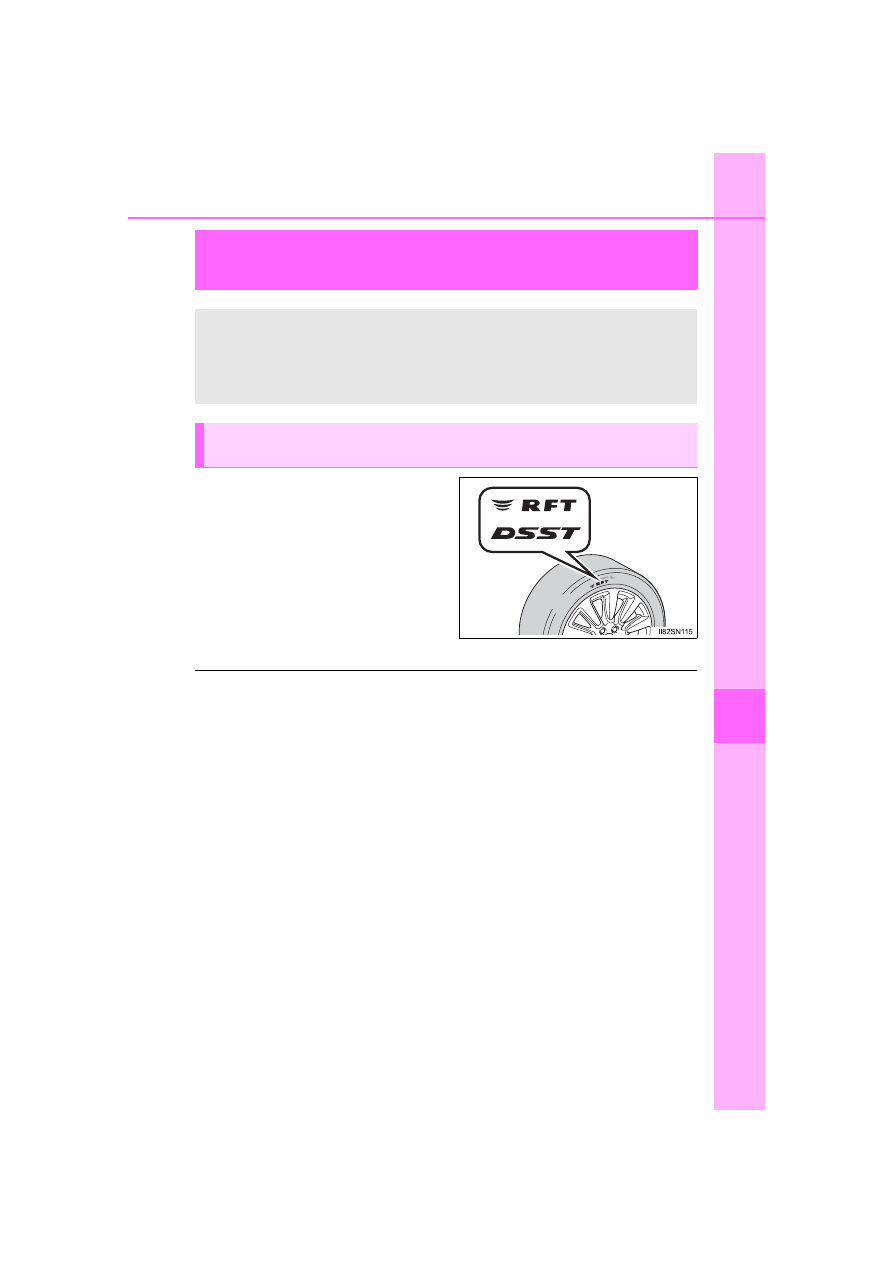
499
SIENNA_OM_OM08025U_(U)
7-2. Steps to take in an emergency
7
Wh
en tro
If you have a flat tire (vehicles with run-flat
tires)
Take your vehicle to the nearest
Toyota dealer or authorized tire
dealer as soon as possible if any
tire goes flat.
The vehicle can be driven for a
maximum of 100 miles (160 km)
at a speed below 50 mph
(80 km/h) after the tire pressure
warning light comes on.
(
?
In some condition (such as at high temperatures)
You cannot continue driving for up to 100 miles (160 km).
?
For the detailed information on run-flat tires
See the tire warranty booklet.
Your vehicle is not equipped with a spare tire, but instead you
can continue driving the vehicle with run-flat tires even if any
tire goes flat.
In this case, slow down and drive with extra caution.
Run-flat tires (A “RFT” or “DSST” mark is molded on the side-
wall)
500
7-2. Steps to take in an emergency
SIENNA_OM_OM08025U_(U)
NOTICE
?
When replacing the tires
When removing or fitting the wheels, tires or the tire pressure warning
valve and transmitter, contact your Toyota dealer as the tire pressure
warning valve and transmitter may be damaged if not handled correctly.
?
When driving over bumps
If a vehicle has a flat tire, the vehicle height will be lower than usual.
Ensure that nothing strikes the bottom of the vehicle.
?
To avoid damaging the tire pressure warning valves and transmit-
ters
When a tire is repaired with liquid sealants, the tire pressure warning
valve and transmitter may not operate properly. If a liquid sealant is
used, contact your Toyota dealer or other qualified service shop as soon
as possible. Make sure to replace the tire pressure warning valve and
transmitter when replacing the tire. (

501
SIENNA_OM_OM08025U_(U)
7-2. Steps to take in an emergency
7
Wh
en tro
If the engine will not start
One of the following may be the cause of the problem:
?
There may not be sufficient fuel in the vehicle’s tank.
Refuel the vehicle.
?
The engine may be flooded.
Try to restart the engine again following correct starting procedures.
(
?
There may be a malfunction in the engine immobilizer system.
(
One of the following may be the cause of the problem:
?
The battery may be discharged. (
P. 505)
?
The battery terminal connections may be loose or corroded.
The engine starting system may be malfunctioning due to an electrical
problem such as an electronic key battery depletion or a blown fuse.
However, an interim measure is available to start the engine.
(
If the engine will not start even though correct starting proce-
dures are being followed (
P. 225, 228), consider each of the fol-
lowing points:
The engine will not start even though the starter motor operates
normally.
The starter motor turns over slowly, the interior lights and head-
lights are dim, or the horn does not sound or sounds at a low
volume.
The starter motor does not turn over (vehicles with a smart key
system)

502
7-2. Steps to take in an emergency
SIENNA_OM_OM08025U_(U)
One of the following may be the cause of the problem:
?
One or both of the battery terminals may be disconnected.
?
The battery may be discharged. (
P. 505)
?
There may be a malfunction in the steering lock system (vehicle
with a smart key system).
Contact your Toyota dealer if the problem cannot be repaired, or if repair
procedures are unknown.
When the engine does not start, the following steps can be used as an
interim measure to start the engine if the engine switch is functioning
normally:
Set the parking brake.
Shift the shift lever to P.
Turn the engine switch to ACCESSORY mode.
Press and hold the engine switch for about 15 seconds while
depressing the brake pedal firmly.
Even if the engine can be started using the above steps, the system
may be malfunctioning. Have the vehicle inspected by your Toyota
dealer.
The starter motor does not turn over, the interior lights and head-
lights do not turn on, or the horn does not sound.
Emergency start function (vehicles with a smart key system)
1
2
3
4
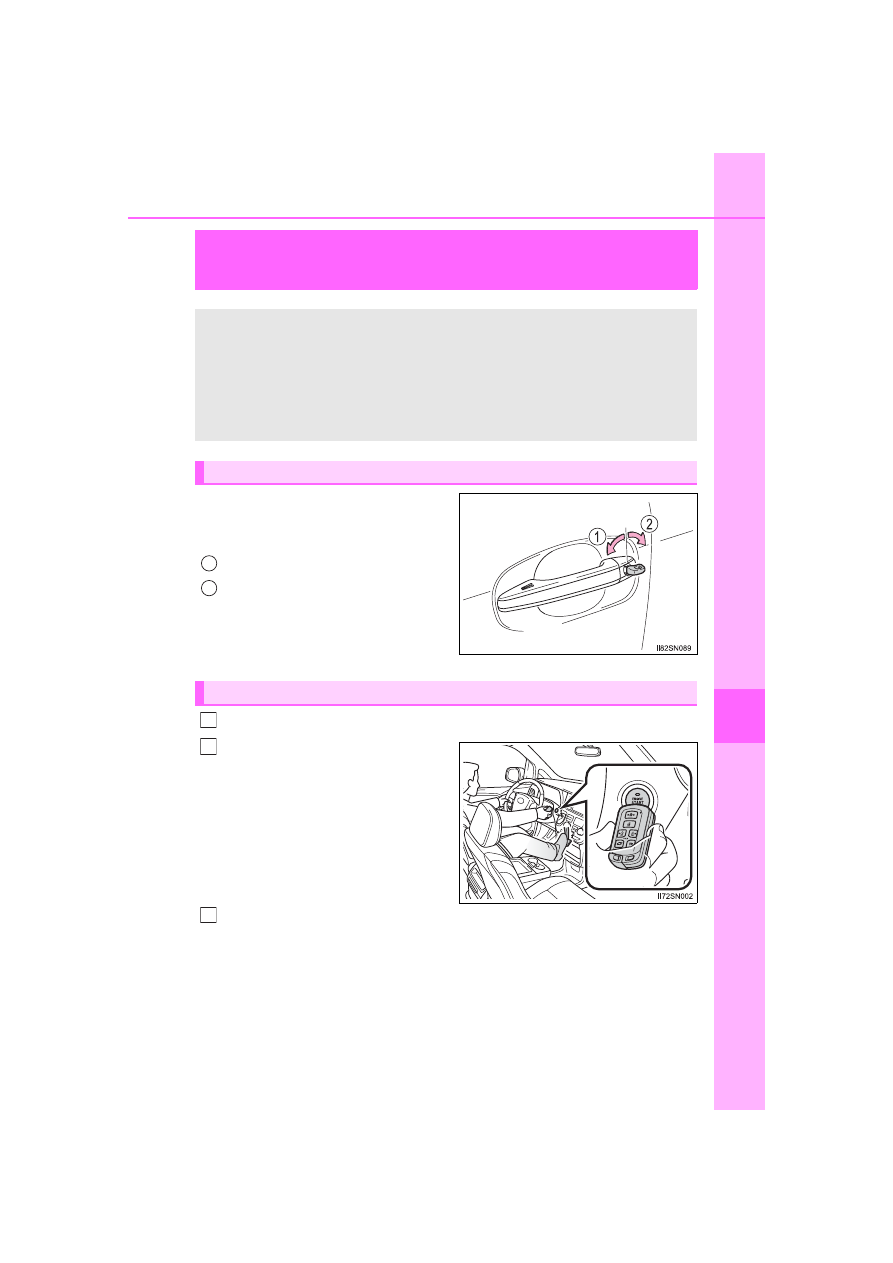
503
SIENNA_OM_OM08025U_(U)
7-2. Steps to take in an emergency
7
Wh
en tro
If the electronic key does not operate
properly (vehicles with a smart key system)
Using the mechanical key
(
P. 106) in order to perform
the following operations.
Locks all the doors
Unlocks the door(s)
Turning the key rearward unlocks
the driver’s door. Turning the key
once again within 3 seconds
unlocks the other doors.
Shift the shift lever to P and apply the brakes.
Touch the Toyota emblem side
of the electronic key to the
engine switch.
An alarm will sound to indicate that
the start function cannot detect the
electronic key that is touched to the
engine switch if any of the doors is
opened and closed while the key is
touched to the switch.
Press the engine switch within 10 seconds after the buzzer sounds,
keeping the brake pedal depressed.
In the event that the engine switch cannot be operated, contact your
Toyota dealer.
If communication between the electronic key and vehicle is
interrupted (
P. 119) or the electronic key cannot be used
because the battery is depleted, the smart key system and wire-
less remote control cannot be used. In such cases, the doors
can be opened or the engine can be started by following the pro-
cedure below.
Locking and unlocking the doors and key linked functions
1
2
Starting the engine
1
2
3
504
7-2. Steps to take in an emergency
SIENNA_OM_OM08025U_(U)
?
Stopping the engine
Shift the shift lever to P and press the engine switch as you normally do when
stopping the engine.
?
Replacing the key battery
As this above procedure is a temporary measure, it is recommended that the
electronic key battery be replaced immediately when the battery depletes.
(
?
Alarm (if equipped)
Using the mechanical key to lock the doors will not set the alarm system.
If a door is unlocked using the mechanical key when the alarm system is set,
the alarm may be triggered. (
?
Changing engine switch modes
Within 10 seconds of the buzzer sounding, release the brake pedal and press
the engine switch.
The engine does not start and modes will be changed each time the switch is
pressed. (
?
When the electronic key does not work properly
?
Check if the battery-saving mode is set. If it is set, cancel the function.
(
?
Make sure that the smart key system has not been deactivated in the cus-
tomization setting. If it is off, turn the function on.
(Customizable features

505
SIENNA_OM_OM08025U_(U)
7-2. Steps to take in an emergency
7
Wh
en tro
If the battery is discharged
If you have a set of jumper (or booster) cables and a second vehicle
with a 12-volt battery, you can jump start your vehicle by following the
steps below.
Vehicles with an alarm system:
Confirm that the electronic key
is being carried.
When connecting the jumper
(or booster) cables, depending
on the situation, the alarm may
activate and doors locked.
(
Open the hood. (
Remove the engine cover.
The following procedures may be used to start the engine if the
vehicle’s battery is discharged.
You can call your Toyota dealer or qualified repair shop.
1
2
3
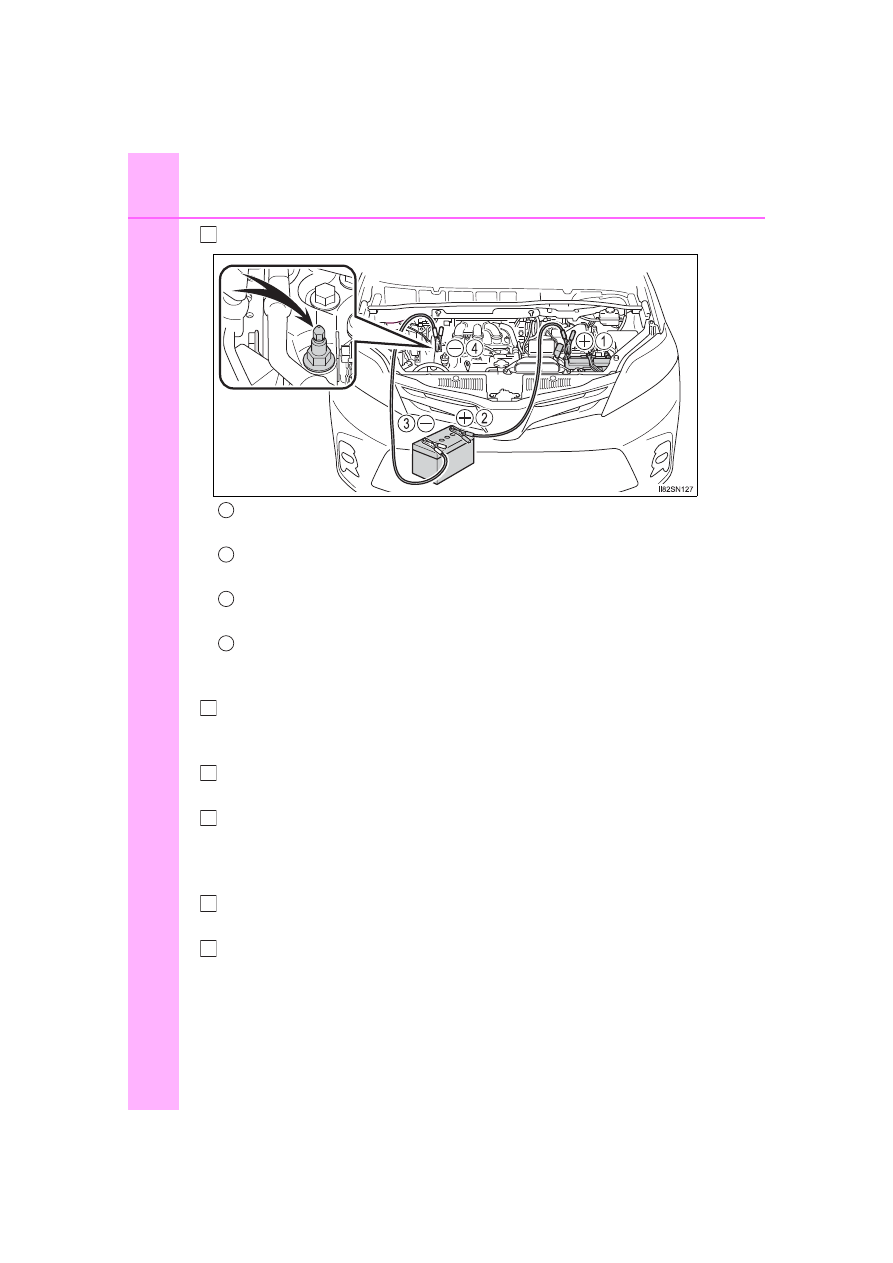
506
7-2. Steps to take in an emergency
SIENNA_OM_OM08025U_(U)
Connect the jumper cables according to the following procedures:
Connect a positive jumper cable clamp to the positive (+) battery
terminal on your vehicle
Connect the clamp on the other end of the positive cable to the
positive (+) battery terminal on the second vehicle
Connect a negative cable clamp to the negative (-) battery termi-
nal on the second vehicle
Connect the clamp at the other end of the negative cable to a
solid, stationary, unpainted metallic point away from the battery
and any moving parts, as shown in the illustration.
Start the engine of the second vehicle. Increase the engine speed
slightly and maintain at that level for approximately 5 minutes to
recharge the battery of your vehicle.
Vehicles with a smart key system only: Open and close any of the
doors of your vehicle with the engine switch off.
Maintain the engine speed of the second vehicle and start the
engine of your vehicle by turning the engine switch to the “ON”
position (vehicles without a smart key system) or turning the engine
switch to IGNITION ON mode (vehicles with a smart key system).
Once the vehicle’s engine has started, remove the jumper cables in
the exact reverse order from which they were connected.
To install the engine cover, conduct the removal procedure in
reverse. After installing, check that the fixed pins are inserted
securely.
Once the engine starts, have the vehicle inspected at your Toyota
dealer as soon as possible.
4
1
2
3
4
5
6
7
8
9
507
7-2. Steps to take in an emergency
SIENNA_OM_OM08025U_(U)
7
Wh
en tro
?
Starting the engine when the battery is discharged
The engine cannot be started by push-starting.
?
To prevent battery discharge
?
Turn off the headlights and the audio/visual system while the engine is off.
?
Turn off any unnecessary electrical components when the vehicle is running
at a low speed for an extended period, such as in heavy traffic.
?
When the battery is removed or discharged
?
The power sliding door (if equipped) must be initialized. (
?
The power back door (if equipped) must be initialized. (
?
Charging the battery
The electricity stored in the battery will discharge gradually even when the
vehicle is not in use, due to natural discharge and the draining effects of cer-
tain electrical appliances. If the vehicle is left for a long time, the battery may
discharge, and the engine may be unable to start. (The battery recharges
automatically during driving.)
508
7-2. Steps to take in an emergency
SIENNA_OM_OM08025U_(U)
WARNING
?
Avoiding battery fires or explosions
Observe the following precautions to prevent accidentally igniting the flam-
mable gas that may be emitted from the battery:
?
Make sure the jumper cable is connected to the correct terminal and that it
is not unintentionally in contact with any other than the intended terminal.
?
Do not allow the other end of the jumper cable connected to the “+” termi-
nal to come into contact with any other parts or metal surfaces in the area,
such as brackets or unpainted metal.
?
Do not allow the + and - clamps of the jumper cables to come into contact
with each other.
?
Do not smoke, use matches, cigarette lighters or allow open flame near
the battery.
?
Battery precautions
The battery contains poisonous and corrosive acidic electrolyte, while
related parts contain lead and lead compounds. Observe the following pre-
cautions when handling the battery:
?
When working with the battery, always wear safety glasses and take care
not to allow any battery fluids (acid) to come into contact with skin, clothing
or the vehicle body.
?
Do not lean over the battery.
?
In the event that battery fluid comes into contact with the skin or eyes,
immediately wash the affected area with water and seek medical attention.
Place a wet sponge or cloth over the affected area until medical attention
can be received.
?
Always wash your hands after handling the battery support, terminals, and
other battery-related parts.
?
Do not allow children near the battery.
NOTICE
?
When handling jumper cables
When connecting the jumper cables, ensure that they do not become entan-
gled in the cooling fans or belt.
?
To prevent damage to the engine cover
?
When removing the cover, make sure that you pull the cover towards you
after lifting the front edge to remove the fixed pins.
?
When installing the cover, do not force the cover or subject it to strong
shocks.

509
SIENNA_OM_OM08025U_(U)
7-2. Steps to take in an emergency
7
Wh
en tro
If your vehicle overheats
Stop the vehicle in a safe place and turn off the air conditioning sys-
tem, and then stop the engine.
If you see steam:
Carefully lift the hood after the steam subsides.
If you do not see steam:
Carefully lift the hood.
After the engine has cooled down sufficiently, inspect the hoses and
radiator core (radiator) for any leaks.
Radiator
Cooling fans
If a large amount of coolant
leaks, immediately contact your
Toyota dealer.
The following may indicate that your vehicle is overheating.
?
The needle of the engine coolant temperature gauge (
enters the red zone or a loss of engine power is experienced. (For
example, the vehicle speed does not increase.)
?
“Engine Coolant Temp is High” is shown on the multi-information
display.
?
Steam is coming from under the hood.
Correction procedures
1
2
3
1
2
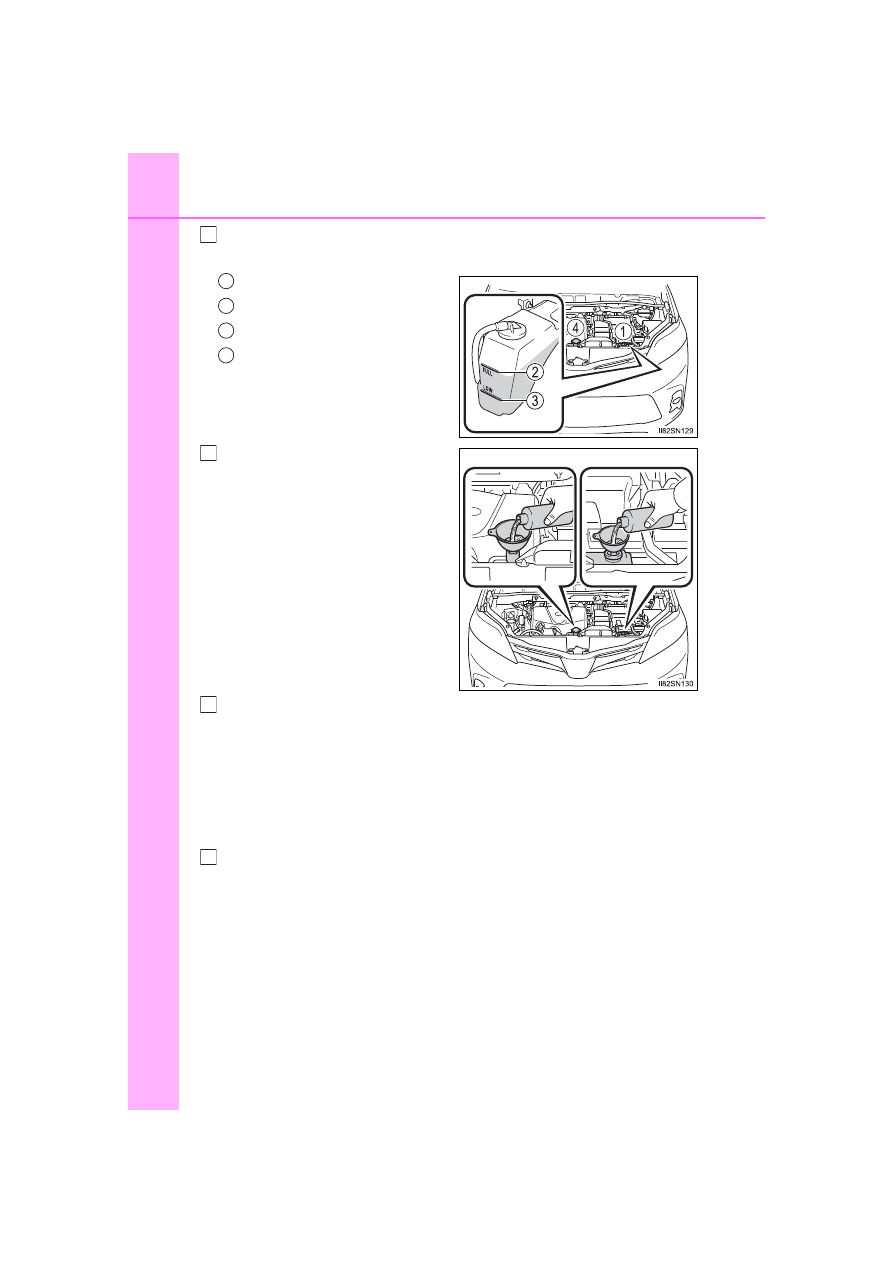
510
7-2. Steps to take in an emergency
SIENNA_OM_OM08025U_(U)
The coolant level is satisfactory if it is between the “FULL” and
“LOW” lines on the reservoir.
Reservoir
“FULL” line
“LOW” line
Radiator cap
Add coolant if necessary.
Water can be used in an emer-
gency if coolant is unavailable.
Start the engine and turn the air conditioning system on to check
that the radiator cooling fans operate and to check for coolant leaks
from the radiator or hoses.
The fans operate when the air conditioning system is turned on immedi-
ately after a cold start. Confirm that the fans are operating by checking the
fan sound and air flow. If it is difficult to check these, turn the air condition-
ing system on and off repeatedly. (The fans may not operate in freezing
temperatures.)
If the fans are not operating:
Stop the engine immediately and contact your Toyota dealer.
If the fans are operating:
Have the vehicle inspected at the nearest Toyota dealer.
4
1
2
3
4
5
6
7
511
7-2. Steps to take in an emergency
SIENNA_OM_OM08025U_(U)
7
Wh
en tro
WARNING
?
When inspecting under the hood of your vehicle
Observe the following precautions.
Failure to do so may result in serious injury such as burns.
?
If steam is seen coming from under the hood, do not open the hood until
the steam has subsided. The engine compartment may be very hot.
?
Keep hands and clothing (especially a tie, a scarf or a muffler) away from
the fan and belts. Failure to do so may cause the hands or clothing to be
caught.
?
Do not loosen the radiator cap or the coolant reservoir cap while the
engine and radiator are hot. High temperature steam or coolant could
spray out.
NOTICE
?
When adding engine coolant
Add coolant slowly after the engine has cooled down sufficiently. Adding
cool coolant to a hot engine too quickly can cause damage to the engine.
?
To prevent damage to the cooling system
Observe the following precautions:
?
Avoid contaminating the coolant with foreign matter (such as sand or dust
etc.).
?
Do not use any coolant additive.
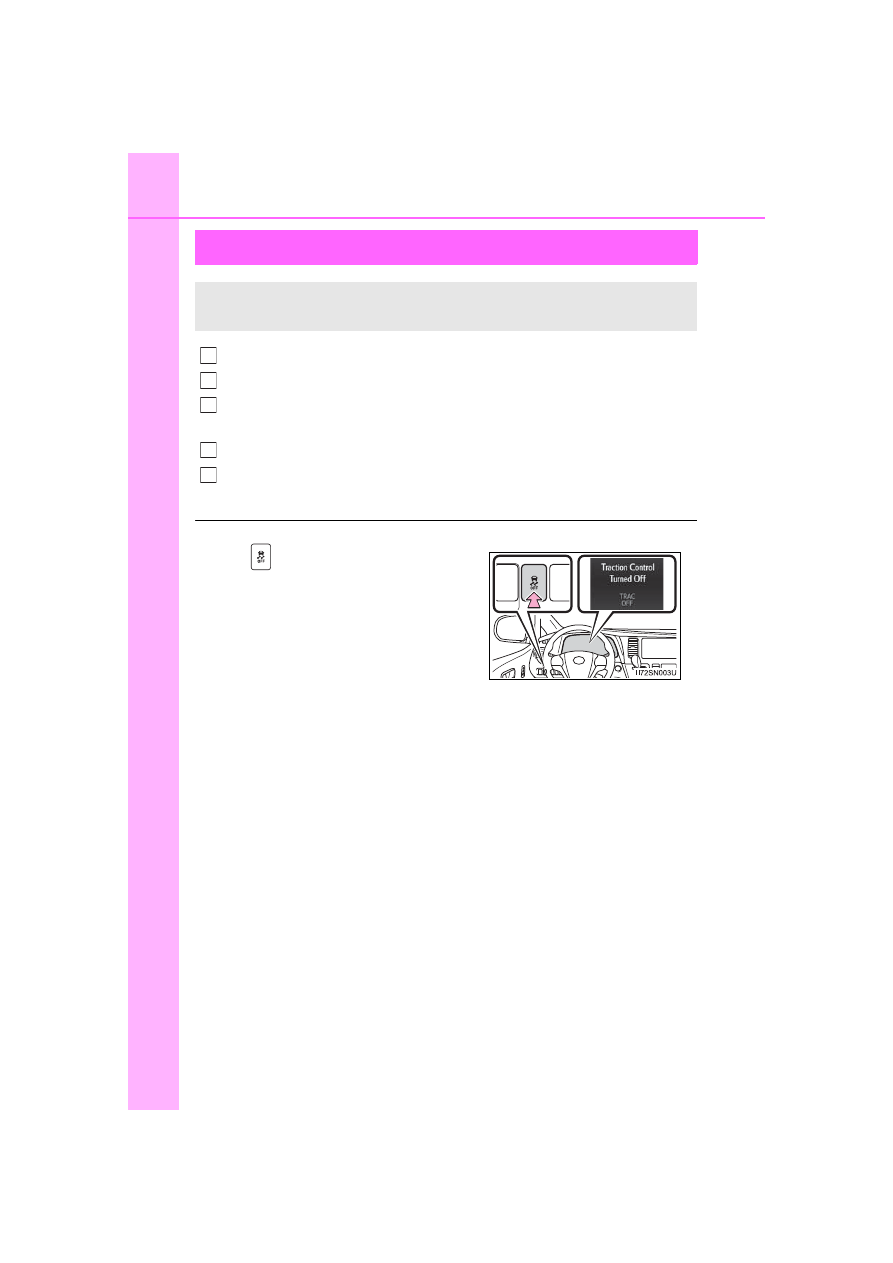
512
SIENNA_OM_OM08025U_(U)
7-2. Steps to take in an emergency
If the vehicle becomes stuck
Stop the engine. Set the parking brake and shift the shift lever to P.
Remove the mud, snow, or sand from around the stuck tire.
Place wood, stones or some other material under the tires to help
provide traction.
Restart the engine.
Shift the shift lever to the D or R and release the parking brake.
Then, while exercising caution, depress the accelerator pedal.
?
When it is difficult to free the vehicle
Carry out the following procedures if the tires spin or the vehicle
becomes stuck in mud, dirt, or snow:
Press
to turn off TRAC. (
1
2
3
4
5

Нет комментариевНе стесняйтесь поделиться с нами вашим ценным мнением.
Текст